Virginia Woolf’s Orlando (1928) is one of the most memorable cases of the benefits of a muse in modern literature – dedicated to Vita Sackville-West, whose androgynous personality inspired the title character, the book was described by Sackville-West’s son, Nigel Nicolson, as “the longest love letter in history”. Woolf and Sackville-West’s decades long relationship, with its passionate forays into romance and underpinning friendship, undoubtedly came with creative benefits to both women. In this blog we are delving into other examples of literary “friends with benefits”: looking at creatively fruitful relationships both platonic and romantic in nature.
Vita and Virginia
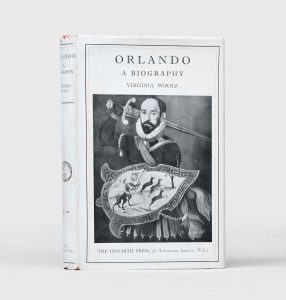 Woolf and Sackville-West first met at the end of 1922, when Vita was 30 and Woolf was 40. Their relationship has been the topic of much scrutiny, including in the 2018 biopic Vita & Virginia. It began against the backdrop of two open and creatively beneficial marriages: Vita and Harold Nicholson both carried out numerous extra-marital affairs, mostly with people of their own gender, while remaining devoted to one another, their children, and their famous garden at Sissinghurst. This shared creative project was the basis for one of Sackville-West’s most beloved works, her 1946 poem The Garden. Virginia and Leonard’s relationship was one of much mutual devotion, though a chaste one. The creative output of Virginia and Leonard Woolf’s marriage came in a different form: he was her first reader, and their Hogarth Press brought a plethora of literary greats into the world.
Woolf and Sackville-West first met at the end of 1922, when Vita was 30 and Woolf was 40. Their relationship has been the topic of much scrutiny, including in the 2018 biopic Vita & Virginia. It began against the backdrop of two open and creatively beneficial marriages: Vita and Harold Nicholson both carried out numerous extra-marital affairs, mostly with people of their own gender, while remaining devoted to one another, their children, and their famous garden at Sissinghurst. This shared creative project was the basis for one of Sackville-West’s most beloved works, her 1946 poem The Garden. Virginia and Leonard’s relationship was one of much mutual devotion, though a chaste one. The creative output of Virginia and Leonard Woolf’s marriage came in a different form: he was her first reader, and their Hogarth Press brought a plethora of literary greats into the world.
Seducers in Ecuador
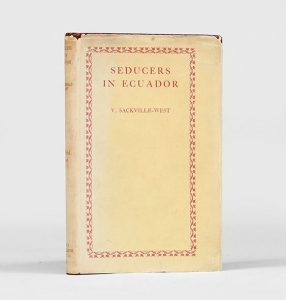 It was Sackville-West who initiated the dedication of their works to one another, four years before Orlando was published in her honour. Woolf invited Sackville-West to submit a novel to the Hogarth Press, the result being Seducers in Ecuador, published on 30 October 1924, with a dedication to Woolf. Woolf praised Sackville-West’s novel as “the sort of thing I should like to write myself”, and in a letter to the author described how much she liked “its texture – the sense of all the fine things you have dropped in to it, so that it is full of beauty in itself when nothing is happening … I am very glad that we are going to publish it, and extremely proud and indeed touched, with my childlike dazzled affection for you, that you should dedicate it to me” (15 September 1924). The two women began their affair the next year.
It was Sackville-West who initiated the dedication of their works to one another, four years before Orlando was published in her honour. Woolf invited Sackville-West to submit a novel to the Hogarth Press, the result being Seducers in Ecuador, published on 30 October 1924, with a dedication to Woolf. Woolf praised Sackville-West’s novel as “the sort of thing I should like to write myself”, and in a letter to the author described how much she liked “its texture – the sense of all the fine things you have dropped in to it, so that it is full of beauty in itself when nothing is happening … I am very glad that we are going to publish it, and extremely proud and indeed touched, with my childlike dazzled affection for you, that you should dedicate it to me” (15 September 1924). The two women began their affair the next year.
Katherine Mansfield
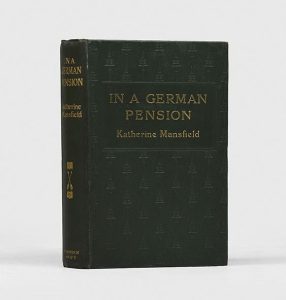 Woolf would write in her diary while producing the work, however, that it was not Sackville-West’s mind that first appealed to her, but her capacity as a woman: “She is stag like or race horse like … and has no very sharp brain. But as a body hers is perfection” (5 July 1924). In contrast, in the months after first meeting her fellow Bloomsbury novelist Katherine Mansfield (1888-1923) she wrote: “to no one else can I talk in the same disembodied way about writing; without altering my thought more than I alter it in writing here”; and noted that she got “the queerest sense of an echo coming back to me from mind the second after I’ve spoken” (2 June 1917). Their important, complicated literary friendship and rivalry never delved into the romantic but was undoubtedly creatively beneficial. It was based around their shared desire to discuss their art, Woolf later describing their conversations as “priceless”. She asked Mansfield to submit a work to be published by the Hogarth Press, and the result, Prelude, was the first novel commissioned. Critics have made much of their relationship: describing them as foils to one another, producing strikingly similar work, and nursing a shared anxiety about being the lesser artist.
Woolf would write in her diary while producing the work, however, that it was not Sackville-West’s mind that first appealed to her, but her capacity as a woman: “She is stag like or race horse like … and has no very sharp brain. But as a body hers is perfection” (5 July 1924). In contrast, in the months after first meeting her fellow Bloomsbury novelist Katherine Mansfield (1888-1923) she wrote: “to no one else can I talk in the same disembodied way about writing; without altering my thought more than I alter it in writing here”; and noted that she got “the queerest sense of an echo coming back to me from mind the second after I’ve spoken” (2 June 1917). Their important, complicated literary friendship and rivalry never delved into the romantic but was undoubtedly creatively beneficial. It was based around their shared desire to discuss their art, Woolf later describing their conversations as “priceless”. She asked Mansfield to submit a work to be published by the Hogarth Press, and the result, Prelude, was the first novel commissioned. Critics have made much of their relationship: describing them as foils to one another, producing strikingly similar work, and nursing a shared anxiety about being the lesser artist.
Sylvia Townsend Warner
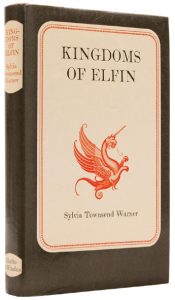 Another of Woolf’s literary friends was Sylvia Townsend Warner, an English novelist, poet, and musicologist, who shared similar mutually beneficial, if emotionally turbulent, creative relationships.
Another of Woolf’s literary friends was Sylvia Townsend Warner, an English novelist, poet, and musicologist, who shared similar mutually beneficial, if emotionally turbulent, creative relationships.
Warner lived as a married couple with her partner, the poet Valentine Ackland, for 38 years, remaining faithful to Ackland despite the latter’s various affairs. Their relationship is visible in their creative output: in their collection of 109 love poems, Whether a Dove or Seagull (1933), their individual boundary pushing publications (Warner notably espoused “unconventional moral fables” in her collection of fairy tales Kingdoms of Elfin in 1977), and in their posthumously published love letters, I’ll Stand By You (1998).
Ackland’s work primarily took the form of poetry, although with her political critique she contributed articles to magazines such as Country Standard, Left Review, and The Countryman. Warner, the more successful and prolific author, was supportive of Ackland’s writing, often putting it before her own, and she used her friendships with many key authors and literary figures of the time to help get Ackland into print.
 Nancy Cunard
Nancy Cunard
One such friendship was with the author and activist Nancy Cunard. Indeed, it had been one of Cunard’s articles in the Daily Worker which prompted the couple, both signed-up members of the Communist party, to travel to Barcelona to volunteer as first-aid workers for the Red Cross in late September 1936. By 1944 the pair had returned to their home in Dorset, and Cunard visited them there to escape the second London Blitz of that year. She too benefited creatively from their friendship, writing Man-Ship-Tank-Gun-Plane while with them; a modernist poem evoking the terror of experiencing war raids.
These literary relationships represent just a handful of those to explore: discover more tales of unusual writing duos with our blog post on Michael Field, or the world of Renée Vivien, Sappho’s first lesbian translator who would go on to set up a school on the island of Lesbos with her lover, and renowned literary host, Natalie Clifford Barney.


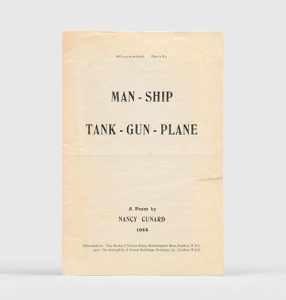 Nancy Cunard
Nancy Cunard


